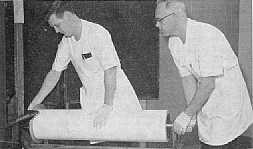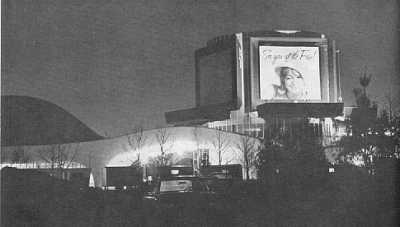|
It stands to reason that the nation's largest
producer of things photographic would make its pavilion at the
New York World's Fair one big montage of photography, and Eastman
Kodak does not disappoint.
Rising above the Eastman Kodak Pavilion
is one of the most spectacular features at the Fair. It is a
giant, circular picture tower displaying five huge outdoor color
prints. Each measuring 30 by 36 feet, they are the largest such
prints in the world.
The pictures will be changed every three
or four weeks while the Fair is open six months this year and
six months next; consequently, there was a need for a great many
special pictures for this part of the Kodak exhibit. That need
set off the most extensive picture-taking project ever for Kodak's
Photo Illustrations Division. People, places and things were
photographed, with emphasis on the beautiful, the dramatic, the
familiar and the unfamiliar. To provide the necessary pictures,
Kodak's in-plant photographers covered the United States by caravan
and flew all over the world.
A 40-inch wide roll
of Ektacolor paper about to be unrolled for printing. This 30-foot
strip is now a section of one of the 30x36-foot tower prints atop
the Kodak pavilion.
 |
The problem with displaying the huge prints
in the tower stimulated some remarkable technical achievements.
For example, Kodak Park scientists had to develop new methods
for protecting the prints, which are exposed to the elements.
However, the most spectacular technical
achievement in connection with the tower display is the special
1,2000,000-watt outdoor lighting system which shines on the giant
prints day and night, making them the world's most brilliantly
lit pictures. This system literally rivals the brilliance of
the sun.
The lights throw a total of 15,000,000
candles on the photos. They are so brilliant that the prints
resemble glowing transparencies, even when the sun is shining
directly on them.
This unprecedented level of illumination
is made possible by a new type of xenon lamp made by Osram GmbH,
a West German firm that specializes in gas discharge lamps. Special
fixtures to accommodate the powerful lamps were made by another
West German firm, Siemens Schuckertwerke.
"To our knowledge, this type of lamp
has never been used in the United States before," said Norman
Macbeth, president of the Macbeth Corporation of Newburgh, N.Y.,
which did the engineering work for the lighting installation.
"They've been tried for a few specialized applications in
Europe, such as airports and football stadiums, but the Kodak
lights concentrate more illumination on the picture tower than
would be used for an entire stadium. The xenon lamps as used
by Kodak constitute an illumination extravaganza such as has
never been seen before."
The Osram lamps are concealed in five outriggers
at the base of each picture. They are in the form of 6 1/2-foot
quartz tubes, arranged in three rows of four lamps within each
outrigger, 12 lamps per picture, or a total of 60 lamps in all.
Each individual lamp is rated at 20,000 watts.
Expressed in terms of light cast, each
of the 60 tubes generates a half-million lumens. six million
lumens fall on the 1,080-square-foot surface of each picture,
or a total of 30,000,000 lumens for all five prints. In comparison,
a 25-watt incandescent bulb casts about 300 lumens.
Despite the fact that precision-designed
reflectors collect almost all of the spilled light and refocus
it on the pictures, the lamps are so powerful that it is possible
at night to read by reflected light alone at a distance of 70
feet.
Three switching and relay stations within
the picture tower, each a 10-foot cube, contains the complicated
tangle of circuits needed to control the lights. Intensity of
illumination can be remote controlled from a console within the
Kodak pavilion's lounge. At night, when the Osram lamps no longer
have to outshine sunlight, the level of illumination is reduced
considerably to avoid any suggestion of glare.
The level of illumination
is reduced considerably at night when the lamps no longer have
to outshine sunlight.
 |
Igniting the big lamps takes 80,000 volts
of electricity. The electrodes, projecting about two inches into
the xenon-filled tube at either end, are of solid tungsten and
are as big around as a finger. Engineers predict about 2,000
hours of operation per lamp.
The electricity needed to run the five
fixtures is equivalent to the electrical needs of approximately
1,700 average U.S. homes, each equipped with a full complement
of lights and electrical appliances.
|